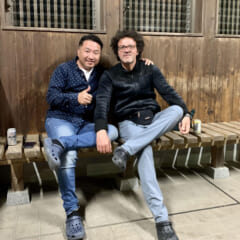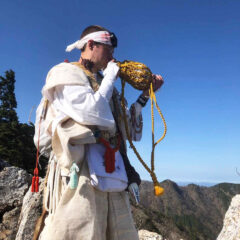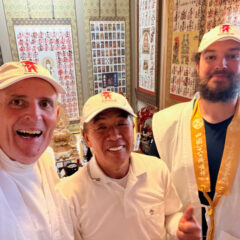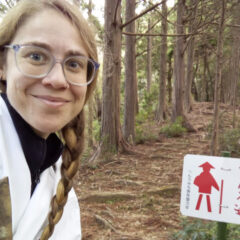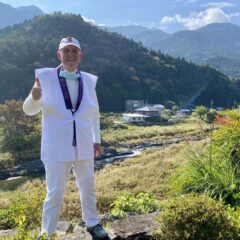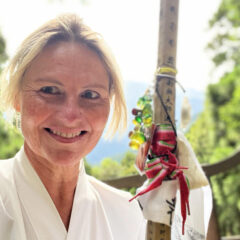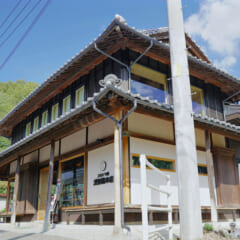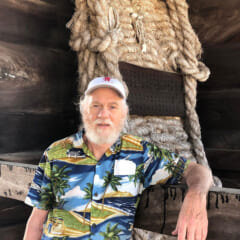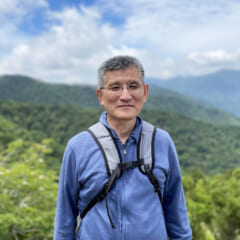My Shikoku Journey (10) by Don, USA
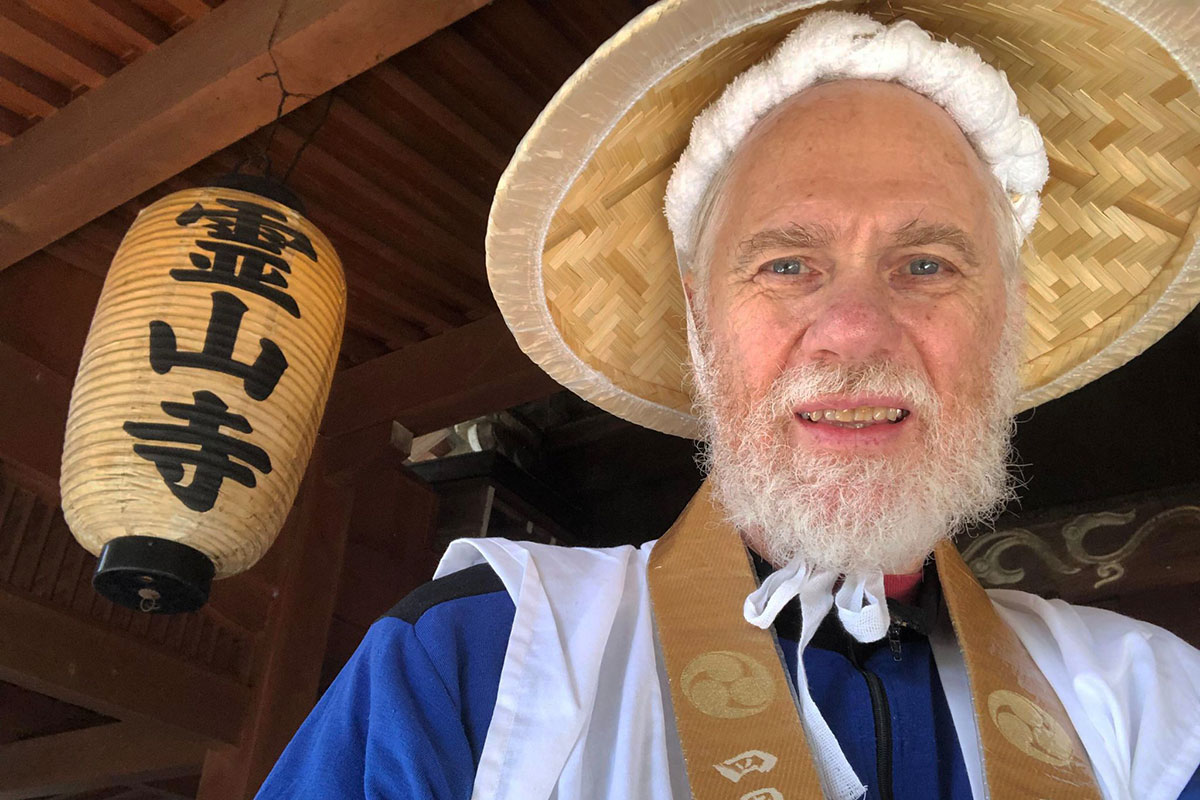
![]() Don Weiss,USA
Don Weiss,USA ![]() Complete Shikoku Pilgrimage
Complete Shikoku Pilgrimage
Again and again, and again…
“Why are you going again?”
“Didn’t you do that last year?”
“You’ve done this so many times, doesn’t it get boring?”
Every spring since I retired, I walk part of the Shikoku Pilgrimage – and also every fall. And every time I do, I get asked the same questions. Again and again and again. I’ve developed some stock responses, which I cycle through, depending on who is asking and how serious I feel at the moment.
Serious Mode:
- I haven’t been to these temples recently.
- I haven’t walked this part of the trail in years and people ask me questions about the route.
- I want to go as many times as I can before I get too old.
- I want to meet and talk with as many other pilgrims as possible.
- It’s never boring. There’s always something new.
Semi-serious:
- I want to see if I can still walk up the hill to [enter temple name here].
- I want to see the cherry blossoms at [enter temple name here].
- I want to see the fall color at [etc.]
Light-hearted Mode:
- My wife needs a vacation from me.
- I haven’t had any really good katsuo no tataki lately.
- Because it’s there.
That last is my favorite. It’s what George Mallory said to a reporter who, like every other reporter, asked him, “Why do you want to climb Mt. Everest?” “Because it’s there,” he answered.
I do the pilgrimage, “because it’s there,” — again and again and again, because: Why not?
I first read about the pilgrimage in 1980. [Nineteen-eighty????? — Yes, 1980.] I was planning a month’s vacation in Japan, so I bought a guidebook. It was 400 pages long and had about seven pages for the whole island of Shikoku. I read (the words are burned on my brain – they changed my life!), “Not many foreigners visit Shikoku. If you go, you are sure to see white-robed pilgrims walking the ancient Eighty-Eight Temples Pilgrimage path.”
I couldn’t resist. After Nikko, Kyoto, etc., etc., I took a ferry from Osaka to Tokushima (no bridges so no trains or buses in those days), then a train to Naruto, and the next morning went to Bando and found my way to Ryozenji – Temple One.
It was a misty day, and somehow that was just perfect! The rain dripped off my straw hat and I found myself walking through a landscape of half-seen hills, lush greenery, and freshly harvested rice paddies. It was exactly what I thought a pilgrimage scene should look like. Then, after visiting the first five temples, I knocked on the door of an old inn that was marked on the photocopied map I held.
Before I could come up with one of the ten Japanese phrases I had memorized (all the Japanese I knew), a young woman opened the door, looked at me, and asked, “May I help you?” !!!!!!! In my three weeks in Japan, I’d met half a dozen Japanese who could speak a little English – here was a fluent speaker running a pilgrim’s inn! Talk about a perfect day! Then, to make the day absolutely supercalifragilisticexpialidociously complete, my dinner at the inn introduced me to what instantly became my favorite food in the world (after chocolate) – katsuo no tataki! (It’s a specialty of Kochi Prefecture, though available all over Japan.)
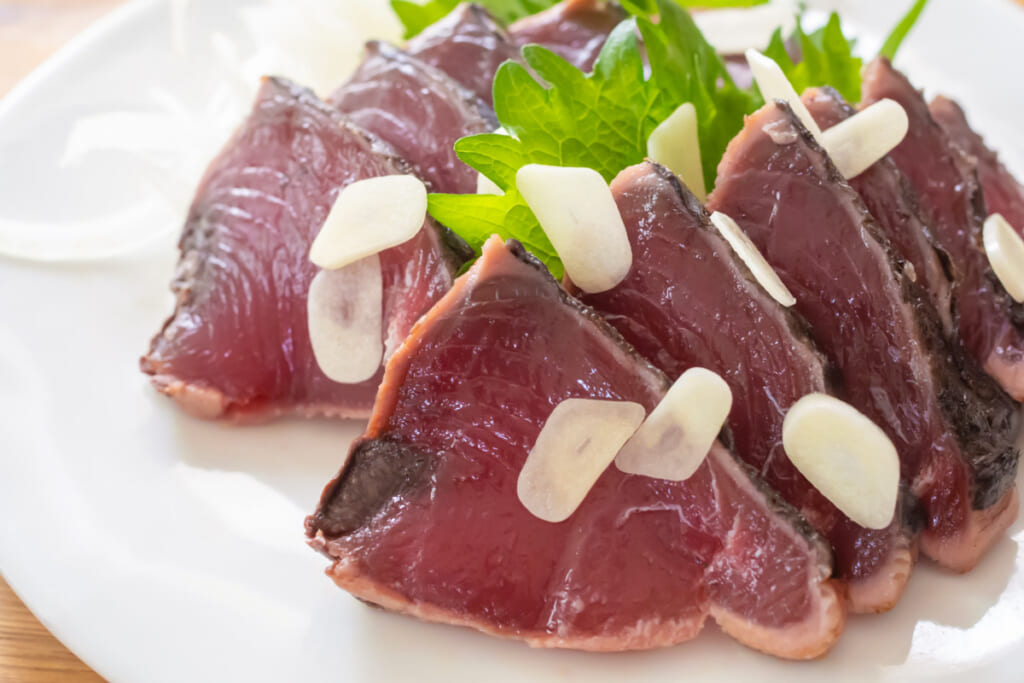
I only visited 12 temples on that trip (1 – 10 plus 30 and 38), but I was hooked. Thirteen years of dreaming later, I returned to Japan, to Shikoku, to Tokushima, to that inn. It was no longer an inn, but the manager had become a friend through 10 years of letters. I stayed there two weeks while she helped me find a teaching job and a house to rent. Two years later, I quit my job and walked the pilgrimage – twice.
Actually, during those two years, I visited all the temples on weekends and during vacations, some once, some many times. I got to know many people who knew the pilgrimage quite well, especially during walks with the Japan Walking Association. I was in my 30s. Most of the Association members were over 60 (many over 70), but I was never one of the fastest walkers. It didn’t matter. I was there to see the temples and stroll through the beautiful countryside.
Sometimes the group stayed overnight at a temple. There were a lot more shukubo (temple lodging houses) in those days. I remember once, the head priest gave a talk to the group before dinner, and closed his remarks by saying, “As pilgrims, I know you have all taken vows to avoid anger, sex, and alcohol during your pilgrimage, but let’s make one small exception.” Then the servers brought out 100 bottles of beer!
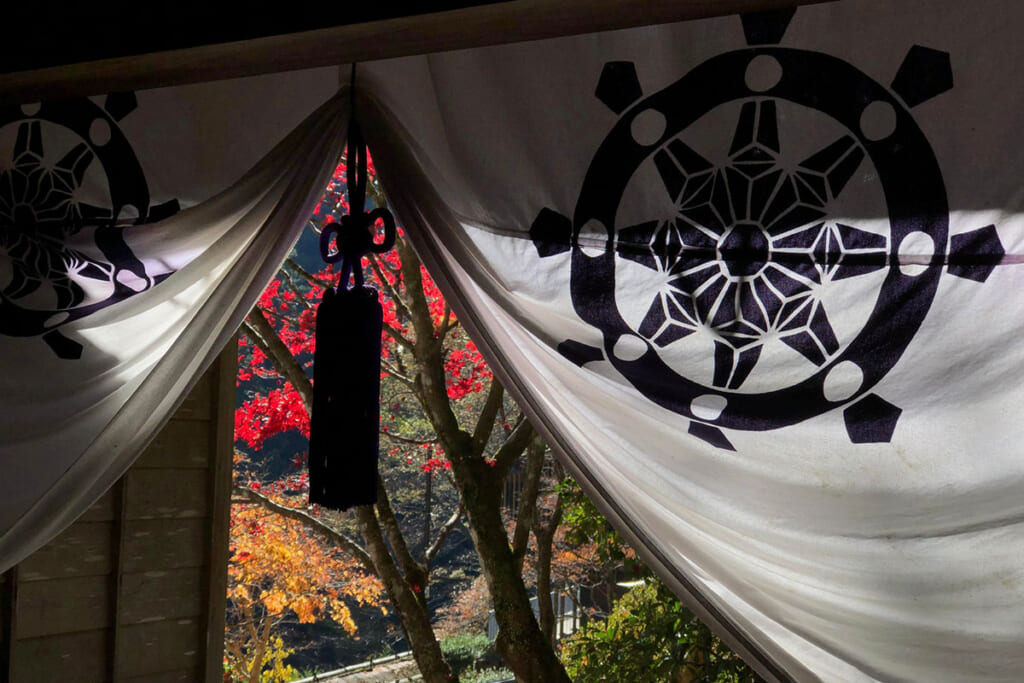
Another great memory of those nichiyo henro (Sunday pilgrim) days:
It was a rainy weekend. I took a train, then a bus, then started walking near Hotsumisakiji – Temple 24, at Cape Muroto. I’d had a late start, so I only made it as far as Ota-ya – a ryokan in front of Shinshoji (#25) for the night – a wonderful room where I hung my dripping clothes to dry and had two of the finest meals of my life (dinner and breakfast), mostly fish from the fishing port across the street. The next morning – still raining – I visited Shinshoji and then walked up to Kongochoji (#26). The rain dripped from trees, temple roofs, and from my clothes. My shoes squished in the puddles. Everything looked perfect in the rain and mist – except for me. I must have looked forlorn, because a man about my age came up and talked to me, asking what my plans were for the day. (His broken English – my broken Japanese). Then he said, “Come with me.” Yes! He had a car!
He not only had a car, he had a schedule: This many minutes to drive from one temple to the next, that many minutes at that temple, lunch at this udon shop, arrive at the next temple at exactly this time . . . We zoomed across the countryside, through the rain, and I got to Kochi Station for my train home after visiting four extra temples that hadn’t been on my own (vague, mental) schedule. I was hardly wet at all!
After my two year’s teaching, I headed out on the henro trail on a cold, clear morning, just after New Year’s. I walked all the way from Ryozenji (#1) to just below Kirihataji (#10) that day – 24 kilometers. I don’t recommend this plan for first timers, but I had visited the first ten temples many times and I didn’t feel I needed to spend more than 15 minutes at each one. Then, the next morning, I visited Kirihataji, then walked up into the mountains to Okuboji (#88), then down towards Nagaoji (#87).
“Why are you walking gyaku uchi?” (reverse order) people asked me, including the priest at Umpenji (#66) a few days later.
“Because I want to meet and talk with other pilgrims,” I said.
“Have you met many?”
“Almost none.”
Hardly anybody does the pilgrimage in the middle of winter, then, now, and always.
So I walked around once, rested for three weeks in Tokushima, then set out again and walked around, toshi uchi (regular order) this time. I met more pilgrims because it was spring and, as Chaucer said regarding the month of April over 600 years ago, “Thanne longen folk to goon on pilgrimages.” — “Then people long to go on pilgrimages.” I finished on an easy date to remember – 5/5/5 – May 5 of the fifth year of the Heisei Era.
I went home to California, but I came back. Then went home again, then came back, lived at a temple, taught English, and did the nichiyo henro routine again. Then again – home, back, nichiyo henro – repeat. (I got married too, but the there and back again pattern repeated, until:
I retired!
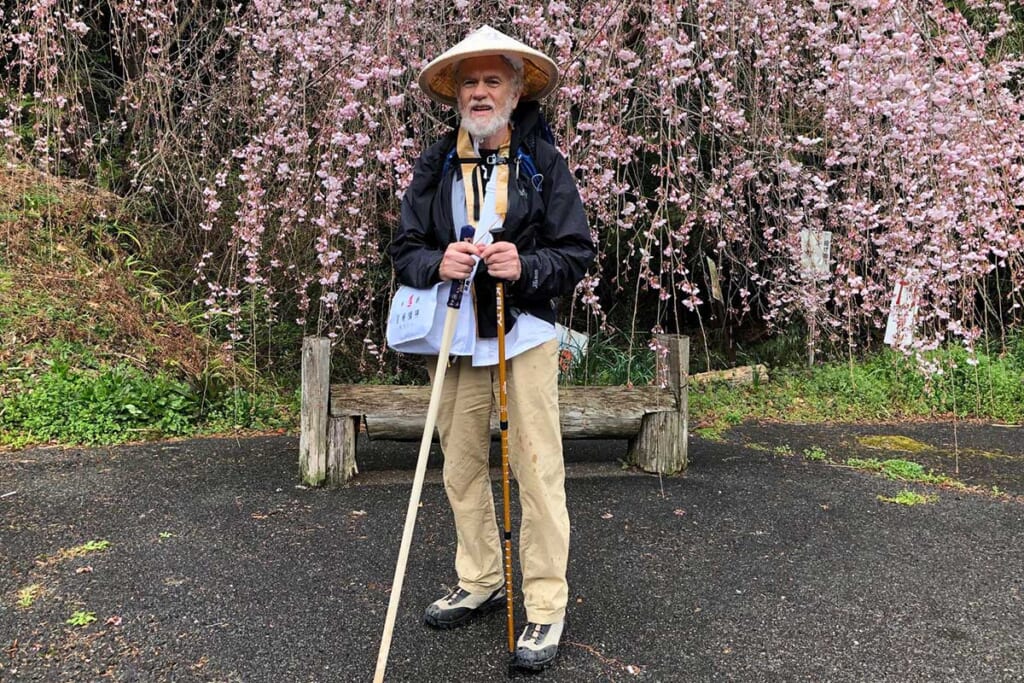
So now my nichiyo henro days are over. Instead, I’ve become a seasonal pilgrim. Ten months out of the year, I’m a Tokushima homebody. My wife still works, so I do the shopping and most of the cooking, I walk on Bizan to stay in shape, but every spring and every fall, I long to “goon on pilgrimages.” I’ve become a kugiri uchi henro – a section hiker, as they say in America. In mid- or late-October, and again in late March or the first of April, I put on a pack and disappear from my usual haunts. I take a train to wherever I left off, or some other convenient starting place, and then I walk.
Actually, these days I don’t exclusively walk the pilgrimage. Sometimes I take a train or bus for 10, 20, or 50 kilometers. Sometimes I go with friends, sometimes alone. Sometimes I stay in one place for five days or more and visit the nearby temples , with a bus or train ride at the beginning or end of the day – sometimes both. (This is “base camp” style.) Like the pirate code in the Jack Sparrow movies, there are no real rules about doing the pilgrimage, though there are guidelines, or you can call them traditions. (Many of the traditions were invented in the 20th century, but that’s a tale for another time.)
In my years going on pilgrimage and talking with other pilgrims, I’ve learned two interesting and important Japanese expressions that come in handy when people ask me those why questions. One is Shikoku byo. That means Shikoku illness. It’s a way of saying that walking the pilgrimage again and again (there are a lot of us) is a kind of addiction, a kind of illness. The other is Shikoku byoin. A byoin is a hospital. It’s a place you go to be cured of an illness. So you can say, if you get Shikoku byo, an addiction to doing the pilgrimage, you can find the right treatment at Shikoku Byoin – Shikoku Hospital – the pilgrimage itself.
So now, as the summer heat starts to build through the rainy days of tsuyu (rainy season), I dream about my fall pilgrimage. I think this time I’m going to walk from Iwamotoji (#37) to Yakuoji (#23). This time, I’ll visit the bangai* and okunoin** that I’ve skipped before. There’s always something new – or something old that I love.
“Why will you go gyaku uchi?”
To meet other pilgrims.
“Why will you go again?”
Because it’s there!
*Bangai – temples related to the pilgrimage that don’t have “official” numbers.
**Okunoin – the inner sanctuary of a temple. Most of the numbered temples have an okunoin. Some have several.


